
HENRY MOORE
20th Century Artists
Bath
Moore's interest in printmaking began after the First World War and continued until the end of his life. It formed an increasingly important part of Moore's work from the 1970s, when he worked with specialist printers and publishers internationally to meet a growing demand for his work.
HENRY MOORE
'If a work of sculpture has its own life and form, it will be alive and expansive, seeming larger than the stone or wood from which it is carved. It should always give the impression, whether carved or modeled, of having grown organically, created by pressure from within.'
- Henry Moore, 1958, quoted by Edouard Roditi

Henry Moore was one of the greatest leading Twentieth Century sculptors, his talents first being noted as he emerged from the Modernist movement in the 1920s. He was born in Yorkshire and later went on to study and teach at the Royal Academy. During the 1930s he lived in Hampstead in the same area as Ben Nicholson, Barbara Hepworth, the critic Herbert Read, and others of the avant-garde. In 1940, after the bombing of his studio, he moved to Much Hadham in Hertfordshire, where he lived for the rest of his life. Most of Moore's early work was carved, rejecting the academic tradition of modeling in favour of the doctrine of truth to material, according to which the nature of the stone or wood--its shape, texture, and so on--was part of the conception of the work. He also rejected the classical and Renaissance conception of beauty and put in its place an ideal of vital force and formal vigour which he found exemplified in much ancient sculpture.
In his contribution to Unit One he wrote in 1934 : 'For me a work must first have a vitality of its own. I do not mean a reflection of the vitality of life, of movement, physical action, frisking, dancing figures, and so on, but that a work can have in it a pent-up energy, an intense life of its own, independent of the object it may represent. When a work has this powerful vitality we do not connect the word Beauty with it. Beauty, in the later Greek or Renaissance sense, is not the aim in my sculpture.'
Moore spent time sketching before each sculpture, slowly building it into the form he wished to create. The majority of his sketches are recorded in his notebooks. He moved away from the preferred technique of casting and would carve directly into the bronze or stone a process that was new to sculpture.
Although he produced some purely abstract pieces, his work was almost always based on forms in the natural world, often the human figure, but also, for example, bones, pebbles, and shells. The reclining female figure and the mother and child were among his perennial themes. Characteristically, Moore's figures are pierced, or contain hollow places. His sculptures have often been interpreted as references to the Yorkshire hills with their large curves and organic forms.
Moore exhibited at the International Surrealist Exhibition in 1936 and was included at the Cubism and Abstract Art exhibition at the Museum of Modern Art, in New York . Two largest collections of his work are held at the Tate, London, and Moore Sculpture Gallery at Leeds City Art Gallery.